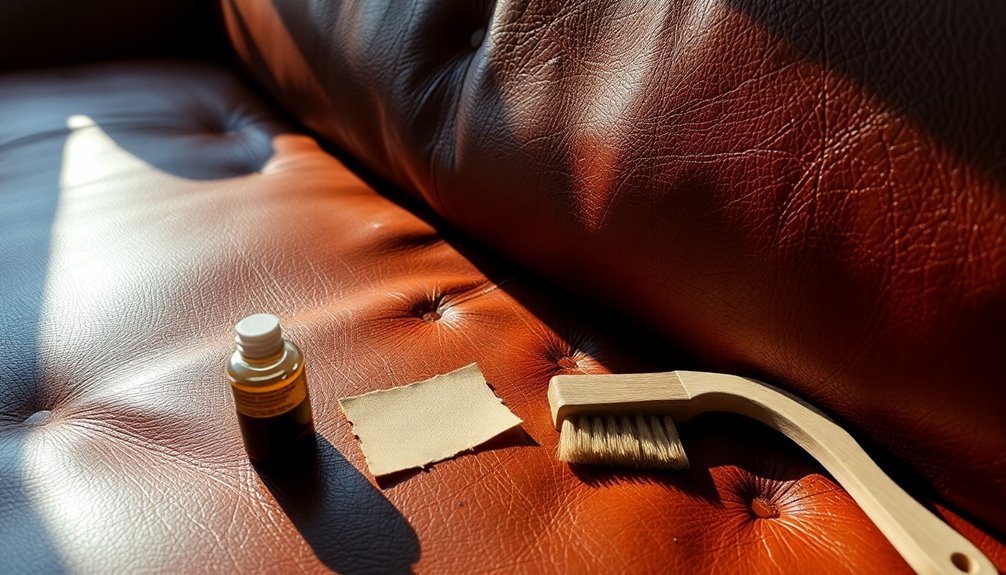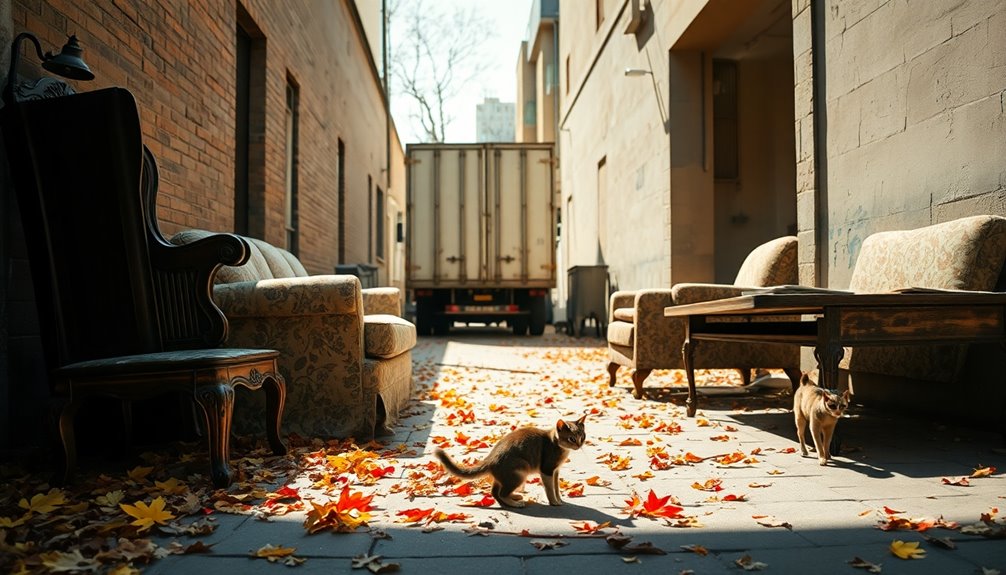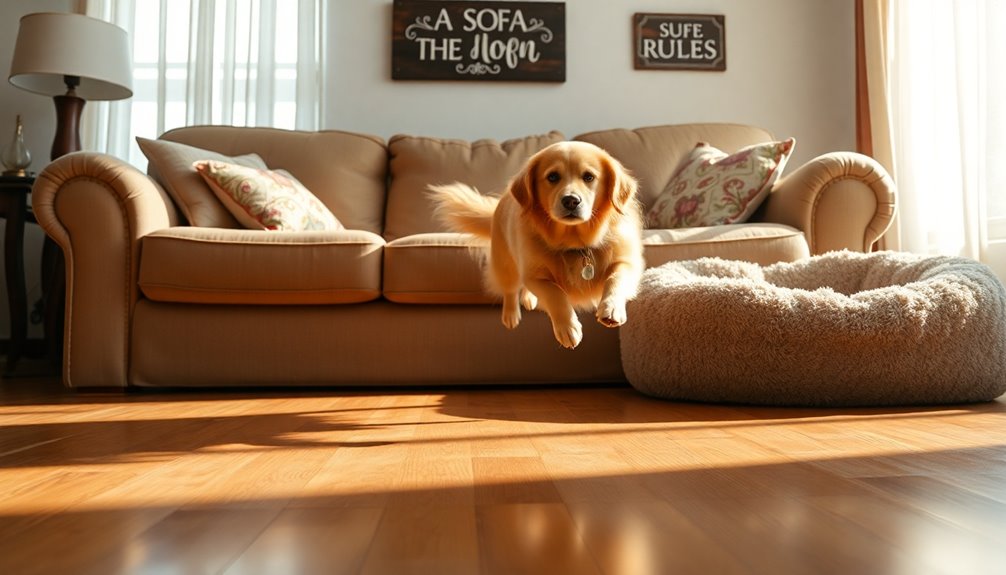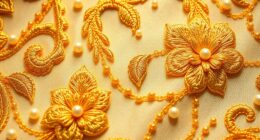To repair peeling on your bonded leather sofa, start by cleaning the area with a mild leather cleaner and a soft cloth. Once dry, use color-matching dye or touch-up markers to fill in peeling areas, applying thin layers and letting each layer dry. Condition the leather every 3-6 months to keep it supple and prevent future peeling. Protect your sofa from direct sunlight and extreme temperatures to maintain adhesive integrity. Finally, consider slipcovers for lasting protection. If you're curious about extending the life of your sofa even further, there are more tips that can really help!
Key Takeaways
- Address peeling immediately to prevent further deterioration and maintain the sofa's appearance.
- Use color-matching dyes or touch-up markers specifically designed for bonded leather for seamless repairs.
- Apply multiple thin layers of dye, allowing each layer to dry completely for better results.
- Regularly clean and condition the sofa every 3-6 months to prevent future peeling and maintain suppleness.
- Consider replacing bonded leather with high-quality leather for enhanced durability and longevity.
Introduction
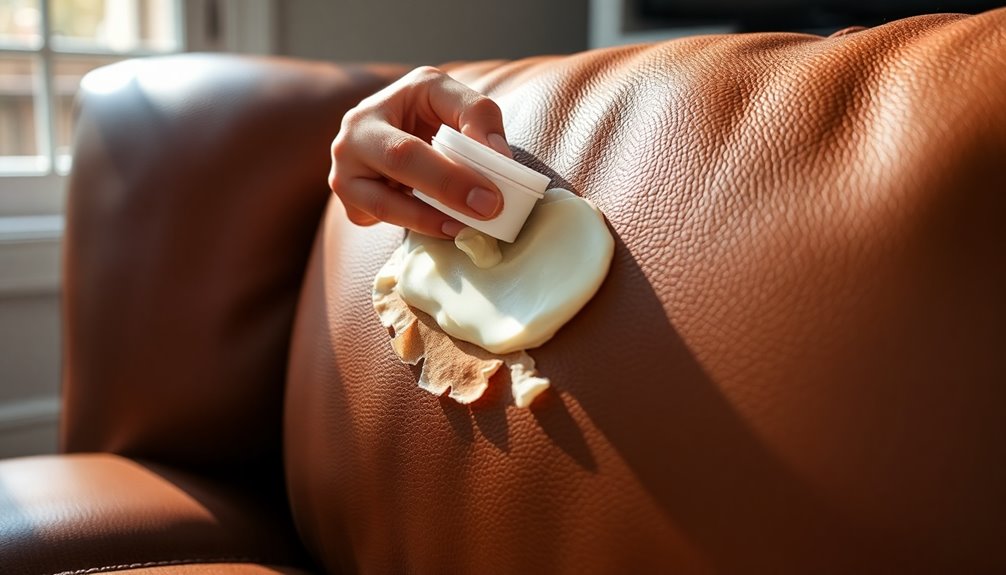
Taking care of your bonded leather sofa is crucial to prevent peeling and maintain its appearance. You'll want to focus on routine leather conditioning, use material-specific cleaning techniques, and address any ink or grease stains promptly. By doing this, you can keep your sofa looking great for years to come.
Routine Leather Conditioning
To keep your bonded leather sofa looking great, regular leather conditioning is essential. This routine leather conditioning helps maintain the suppleness of your sofa and prevents it from drying out, which can lead to unsightly peeling. Aim to condition your sofa every 3-6 months using a high-quality leather conditioner specifically designed for bonded leather materials.
When you apply conditioner, it creates a protective barrier that helps resist moisture and environmental factors that can contribute to degradation. To ensure an even application, always use a non-abrasive cloth. This will help you avoid damaging the surface during the process.
Material-Specific Cleaning Techniques
Maintaining the appearance of your bonded leather sofa goes beyond conditioning; it also involves proper cleaning techniques tailored specifically for this material. Start by using a mild leather cleaner and a soft cloth to gently wipe down the surface. This approach helps avoid damage and prevents further peeling. Always remember, harsh chemicals or abrasive materials can weaken the bonding agents in bonded leather, leading to faster deterioration.
Regularly inspect your bonded leather for signs of wear, such as hairline cracks or peeling. Timely maintenance is key to addressing issues before they worsen. When cleaning, it's wise to test any solution on an inconspicuous area first. This step ensures that the cleaner doesn't cause discoloration or additional damage to your bonded leather.
Treating Ink and Grease Stains
Stains can be a frustrating challenge for bonded leather sofa owners, but addressing them promptly can prevent long-term damage. If you find an ink stain on your sofa, act quickly by blotting the area with a clean cloth to absorb any excess ink. Then, mix isopropyl alcohol with water and apply it gently using a cotton swab. Always test this mixture on an inconspicuous area first to ensure it won't cause peeling leather.
For grease stains, sprinkle cornstarch or talcum powder over the affected area and let it sit for several hours. This allows the powder to absorb the grease effectively. Afterward, gently brush off the powder without rubbing, as this could worsen the damage and lead to peeling or flaking.
Once you've treated the stains, clean the area with a mild leather cleaner and conditioner to restore moisture and prevent further deterioration. Regular maintenance and prompt stain treatment can significantly extend the life of your bonded leather, keeping it looking good and preventing peeling leather issues. Remember, taking quick action is key to maintaining your sofa's appearance and integrity.
Avoiding Direct Sunlight
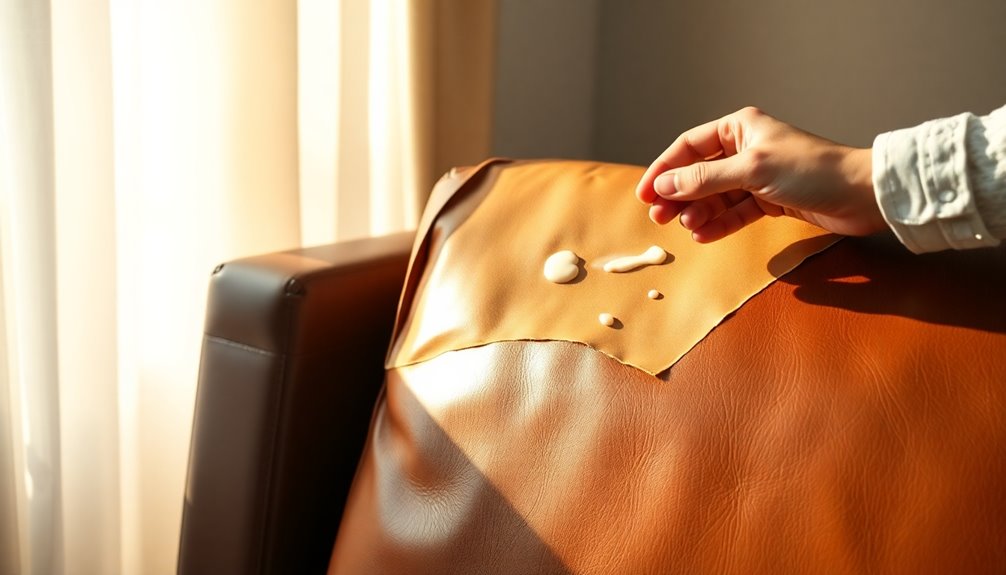
When it comes to protecting your bonded leather sofa, avoiding direct sunlight is crucial. You can enhance its durability by using scratch-resistant furniture fabrics, stylish slipcovers, and regularly applying leather conditioner. These steps not only prevent peeling but also keep your furniture looking great for years to come.
Scratch-Resistant Furniture Fabrics
Although many people enjoy the aesthetic appeal of bonded leather furniture, it can be vulnerable to damage from direct sunlight. Exposure to UV rays can accelerate degradation, causing the bonded leather to dry out and peel more quickly as the bonding agents break down. To protect your investment, consider incorporating scratch-resistant furniture fabrics into your space. These fabrics often come with protective coatings that shield against UV rays, helping to maintain the integrity of the material over time.
To minimize damage, maintain a shaded environment for your bonded leather pieces. Using window treatments, like curtains or blinds, can significantly reduce fading and deterioration. Regularly applying leather conditioners can also enhance your furniture's resilience against sunlight and environmental factors, prolonging its life. Additionally, understanding the importance of energy-efficient models can help you select furniture that not only looks good but also withstands environmental stressors effectively.
If you're in the market for new furniture, look for options with built-in UV protection or high-quality synthetic materials. These alternatives can provide greater durability compared to bonded leather, offering better resistance against the damaging effects of direct sunlight. By being proactive about your furniture's exposure to sunlight, you can ensure its longevity and keep it looking great for years to come.
Protect With Stylish Slipcovers
Stylish slipcovers offer an effective solution for protecting your bonded leather sofa from the damaging effects of direct sunlight. UV exposure can cause the material to deteriorate and peel over time, but with the right slipcovers, you can prevent this damage. Opt for slipcovers made from breathable fabrics to help reduce moisture accumulation, further safeguarding the bonded leather underneath.
Regularly changing or washing your slipcovers is essential. This practice prevents dirt and oils from transferring onto the sofa, minimizing the risk of peeling caused by neglect. With various designs and colors available, you can refresh your sofa's aesthetic while extending its lifespan.
Ensure your slipcover fits snugly to avoid unnecessary friction and movement, which can contribute to wear and peeling of the bonded leather. A well-fitted slipcover not only protects but also enhances the overall look of your living space. By investing in stylish slipcovers, you're taking a proactive step in maintaining your bonded leather sofa, ensuring it stays beautiful and functional for years to come. Don't underestimate the impact of a good slipcover—it's your sofa's best defense against the sun!
Regularly Apply Leather Conditioner
To keep your bonded leather sofa looking its best, regularly applying a leather conditioner is essential. This will help maintain the suppleness of the material, preventing it from drying out and peeling due to environmental factors. Aim to condition your sofa every 3 to 6 months to keep it hydrated and reduce the risk of deterioration.
When choosing a leather conditioner, opt for one that's specifically formulated for bonded leather. This ensures compatibility and effectively replenishes lost moisture. Just as important as conditioning is protecting your sofa from direct sunlight. UV rays can weaken the bonding agents in bonded leather, leading to premature peeling and flaking.
To minimize exposure, consider using protective covers or placing your sofa in a shaded area. This simple step can significantly enhance the longevity of your bonded leather surface. By regularly applying leather conditioner and avoiding direct sunlight, you can keep your sofa looking great for years to come. Remember, a little maintenance goes a long way in preserving the beauty and functionality of your furniture. So, make it a habit to care for your bonded leather sofa properly.
Routine Leather Care Tips
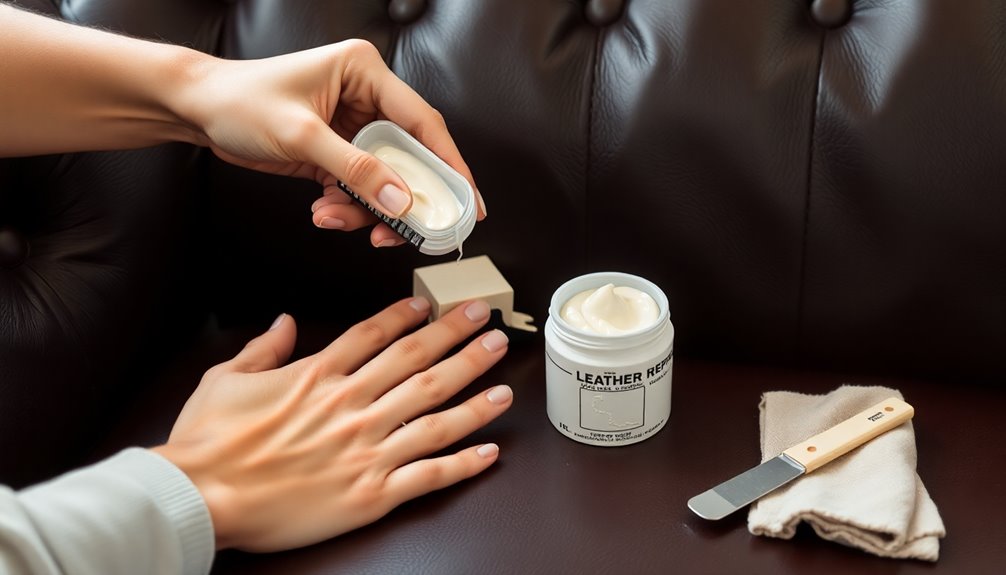
To keep your bonded leather sofa looking its best, you need to pay attention to routine care. Regular cleaning and conditioning help strengthen weak adhesive bonds and enhance the leather's appearance. By using the right treatment and repair techniques, you can ensure your sofa stays cozy and vibrant for years to come.
Weak Adhesive Bonds
Although bonded leather can be a durable material, weak adhesive bonds often lead to peeling if not properly cared for. To maintain the integrity of these bonds, regular cleaning is essential. Use a mild leather cleaner and conditioner to prevent dirt buildup that can compromise the surface.
It's also crucial to protect your bonded leather from extreme temperatures and direct sunlight. These environmental factors can degrade the adhesive bonds over time, resulting in peeling. When cleaning, steer clear of abrasive materials or harsh chemicals, as they can damage the surface and weaken the adhesive bonds.
Consider utilizing protective coverings or cushions to minimize friction and wear. This simple step can significantly reduce the likelihood of developing weak adhesive bonds. Additionally, conduct regular inspections for early signs of wear. By addressing issues promptly, you can help maintain the strength of the adhesive bonds and prolong the life of your bonded leather sofa.
Leather Treatment and Repair
Taking care of your bonded leather sofa is essential for keeping it looking great and extending its lifespan. Regularly clean your sofa using a mild leather cleaner and a soft cloth to remove dirt and prevent buildup that can lead to peeling bonded surfaces. Aim to wipe down your sofa weekly to maintain its appearance and integrity.
Every 3-6 months, apply a leather conditioner. This step keeps the material supple and prevents drying out, which can contribute to peeling. Remember, harsh chemicals and abrasive materials can damage the surface, weakening the bonding agents in your bonded leather. Stick to products specifically designed for leather care.
Additionally, protect your sofa from direct sunlight and extreme temperatures. These environmental factors can degrade the bonding agents, leading to peeling and other damage. Conduct routine inspections for early signs of wear, like hairline cracks or discoloration. Catching these issues early lets you make timely repairs before more significant damage occurs. By following these care tips, you can significantly extend the life of your bonded leather sofa and keep it looking its best.
Cozy Leather Revitalization Techniques
A cozy leather sofa can transform your living space, but keeping it in top shape requires some routine care. Start by regularly cleaning your bonded leather with a mild leather cleaner and a soft cloth. This simple step prevents the buildup of dirt and oils that can lead to peeling. Remember to condition the leather every 6-12 months using a quality leather conditioner to maintain its suppleness and prevent drying, which reduces the risk of peeling.
Be mindful of your sofa's environment. Avoid exposing bonded leather to direct sunlight and extreme temperatures, as these factors can degrade the bonding agents and cause peeling. When cleaning, always use non-abrasive materials and steer clear of harsh chemicals, since they can damage the surface and exacerbate any peeling issues.
Additionally, consider implementing protective coverings or cushions on frequently used areas. This minor adjustment can significantly minimize wear and tear, extending the life of your bonded leather sofa. By following these cozy leather revitalization techniques, you'll keep your sofa looking fresh and inviting for years to come.
Color Matching and Touch-Ups
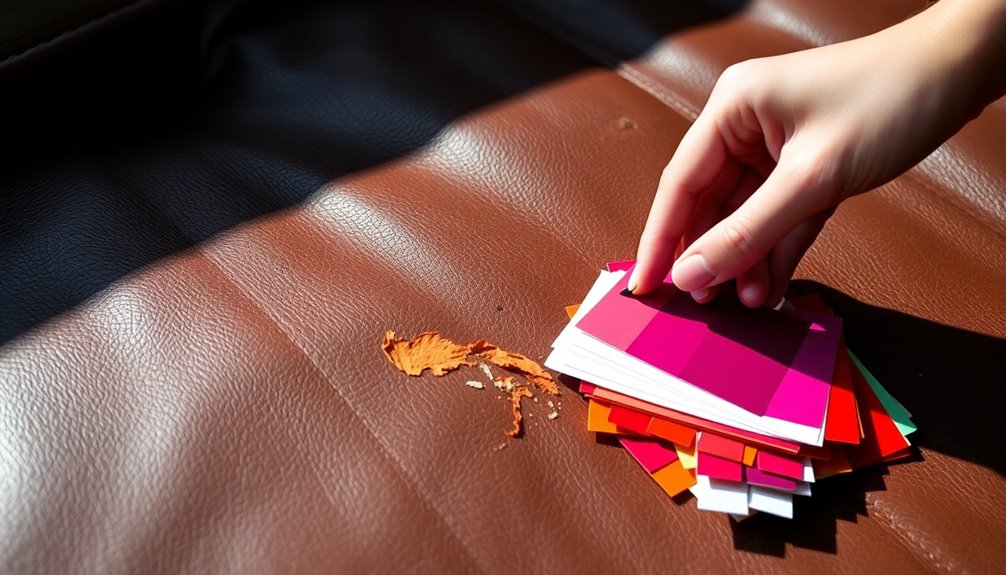
When repairing peeling bonded leather, achieving a seamless color match is crucial for a professional-looking finish. Start by selecting a color-matching dye or touch-up marker specifically designed for leather. Before applying any solution, test it on an inconspicuous area of your sofa to ensure it blends well with the existing color and texture.
Once you've confirmed compatibility, apply multiple thin layers of dye, allowing each layer to dry completely before adding the next. This method helps you achieve the desired color match without overwhelming the surface. If you have color swatches or samples from the original material, use them as references to enhance your matching process.
Seasonal Temperature Adjustments
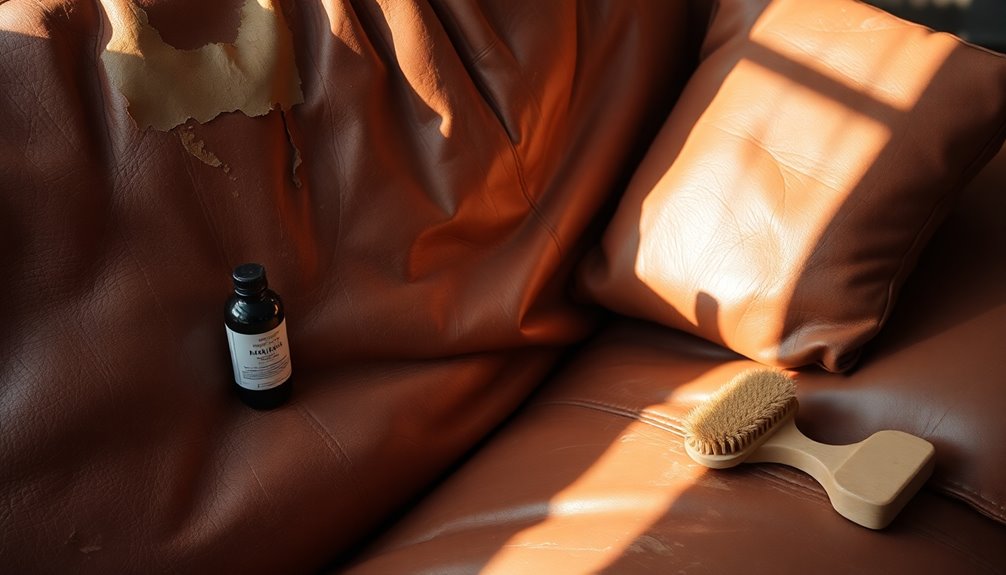
Maintaining optimal conditions for your bonded leather sofa is essential for its longevity and appearance. Seasonal temperature fluctuations can seriously affect the bonding agents in bonded leather, leading to an increased risk of peeling and deterioration. To preserve the integrity of your sofa, aim to keep the indoor temperature between 60°F and 75°F. This range minimizes the environmental stressors that can cause damage.
Additionally, pay attention to humidity levels. Keeping humidity between 30% and 50% is crucial to prevent the leather from drying out or becoming too moist, both of which can weaken its structure. Excessive heat can exacerbate peeling issues, so avoid placing your bonded leather sofa near heat sources like radiators or in direct sunlight.
Regularly adjusting the temperature and humidity in your home can significantly prolong the lifespan of your bonded leather furniture. By creating a stable environment, you can help ensure your sofa remains in great shape and resists the wear and tear that leads to peeling. Make these adjustments a routine part of your home maintenance, and you'll be rewarded with a more durable and attractive bonded leather sofa.
Conclusion
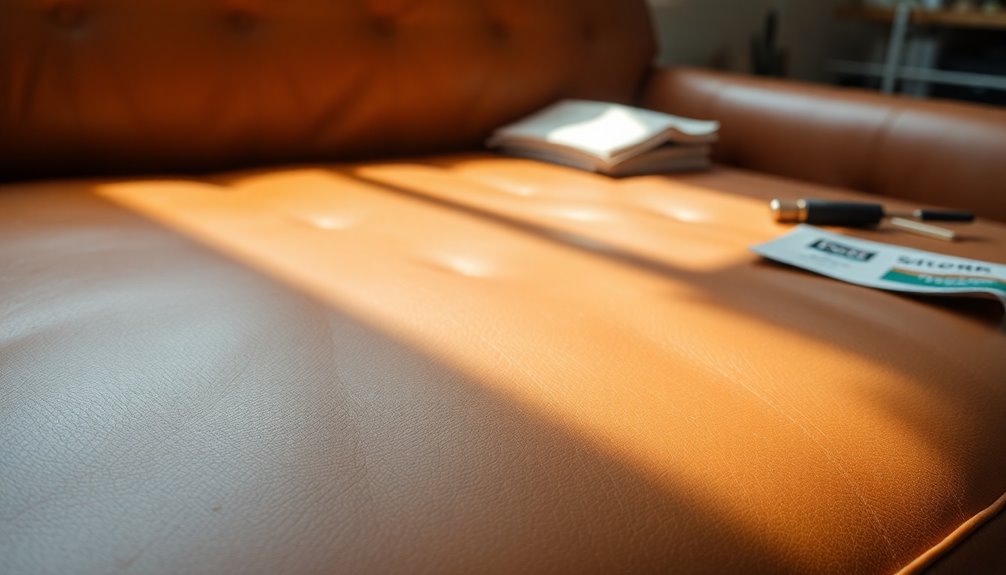
Repairing a bonded leather sofa that's peeling can seem daunting, but with the right approach, you can restore its appearance and extend its life. Start by assessing the damage and cleaning the affected areas thoroughly. This initial step is crucial, as dirt and debris can hinder the effectiveness of the repair. You'll need specialized adhesives or fillers to address the peeling; applying these correctly can make a significant difference.
Regular maintenance, including cleaning and conditioning, is key to preventing future peeling. By giving your bonded leather sofa the care it deserves, you can greatly enhance its durability. If you do encounter peeling, remember that color matching is essential during repairs—mismatched tones can detract from the overall look. Touch-up markers or dyes can help you achieve a seamless blend.
Don't ignore peeling, as it can lead to further deterioration, compromising both the aesthetic and structural integrity of your sofa. While repairs can work wonders, consider the long-term benefits of replacing your bonded leather with high-quality leather for greater durability. Additionally, understanding energy-efficient appliances can help improve your home's overall sustainability. With these strategies, you can keep your bonded leather sofa looking great for years to come.
Frequently Asked Questions
Can Peeling Bonded Leather Be Repaired?
Yes, peeling bonded leather can be repaired. You can start by cleaning the affected area to remove any dirt or oils. Then, apply a flexible adhesive to bond the layers back together. After that, use specialized leather paint to match the color and texture. While these repairs can improve appearance, keep in mind that they might not last long due to the material's nature. Regular maintenance helps extend the life of your bonded leather.
How to Fix a Fake Leather Couch That Is Peeling?
To fix a fake leather couch that’s peeling, start by cleaning the area with a mild leather cleaner. Carefully remove any loose or damaged pieces, taking care not to harm the underlying fabric. If possible, reattach these sections with a flexible adhesive made for leather. For completely peeled areas, use a leather filler to create a smooth surface, then recolor with a matching touch-up marker or dye. Finally, apply a leather conditioner for added protection. It’s important to allow ample drying time between each step to ensure the best results. Additionally, consider applying a protective spray designed for faux leather to prevent future damage. By following these steps, you’ll learn how to repair peeling leather sofas and extend the life of your furniture.
Can You Reupholster Bonded Leather?
Yes, you can reupholster bonded leather, but it might not significantly improve its lifespan. Before diving in, check the underlying frame and stuffing; if they're in bad shape, the comfort won't last long. A professional upholsterer can assess whether reupholstering is worth it or if you should consider a replacement. Opting for higher-quality materials can enhance your sofa's look and durability far more than sticking with bonded leather.
Why Is My Expensive Leather Couch Peeling?
Your expensive leather couch might be peeling due to several factors. Often, it's made from bonded leather, which combines scraps and bonding agents, making it less durable. Over time, these weak bonds can deteriorate, especially in high-use areas. Environmental conditions like humidity and sunlight can further degrade the material. Additionally, if you don't maintain it properly by cleaning and conditioning, dirt and oils can contribute to the peeling issue.
